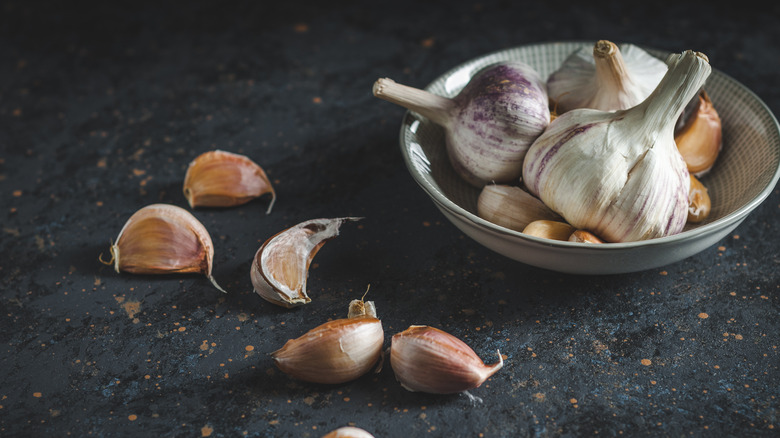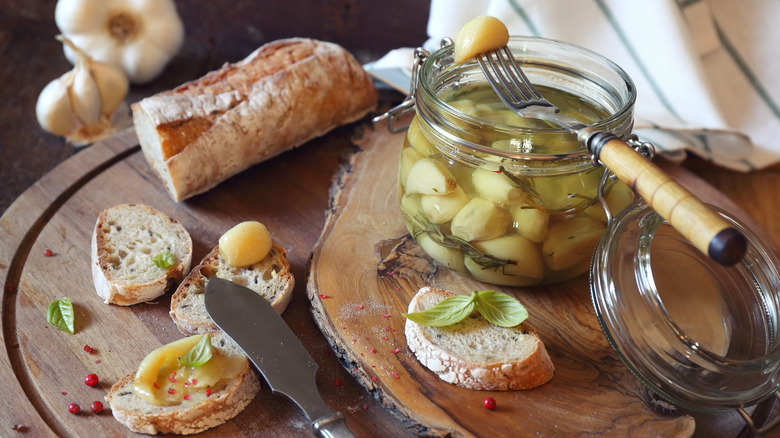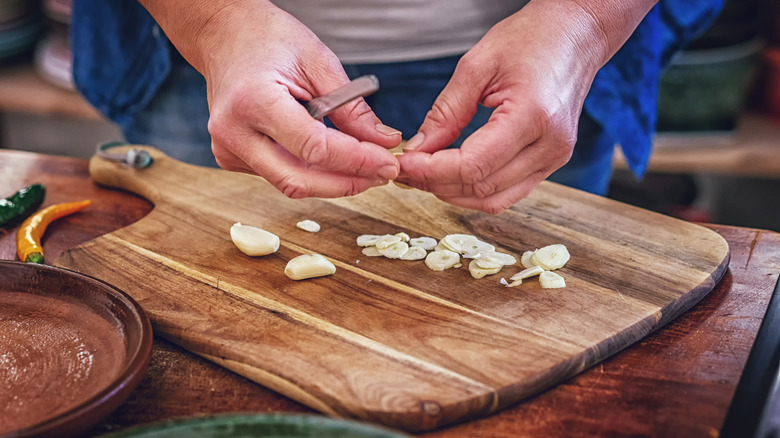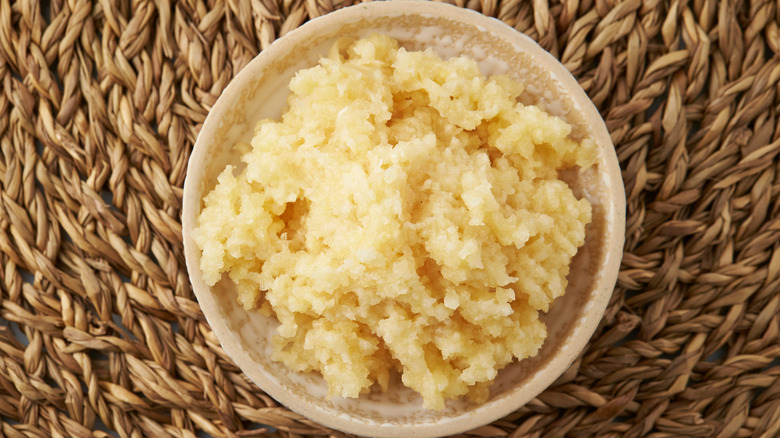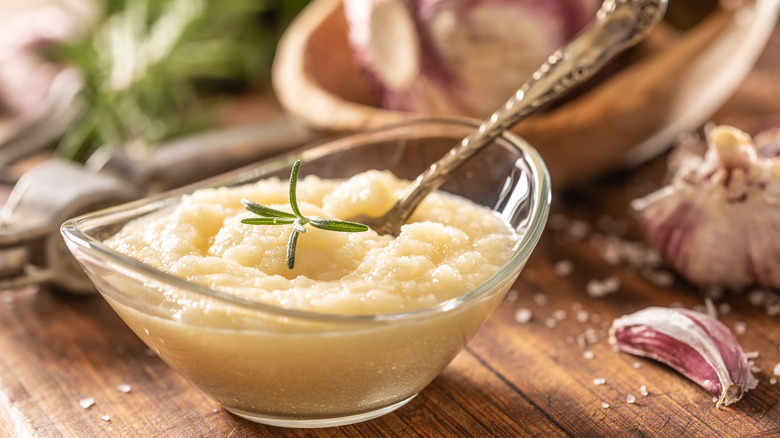All The Different Ways To Cut Garlic And How It Affects Taste
Garlic is an essential ingredient that is widely loved regardless of what form it comes in, whether crushed into a gritty paste, infused into butter, sliced or chopped into tiny pieces, or eaten whole by the clove. There's typically little bias on how the allium is cooked and served, so as long as that garlicky flavor hits the right spot. But, as it turns out, how garlic is prepped and chopped matters more than we may think, with different methods leading to varying amounts of that deep umami-rich savory flavor.
Garlic contains a sulfur compound known as allicin. Although this compound acts as a repellent to keep bugs, pests, and animals away as the allium grows, it's also what gives cloves their signature flavor. But the key for the allicin to transform from an insect repellent to a flavor bomb is oxygen. Usually, this enzyme is caged inside the cell walls of a garlic clove, but as soon as the clove is peeled and sliced into, the allicin releases and is exposed to the air, which consequently unlocks its potent flavor.
What this really means is that the more that garlic is sliced and chopped, the more this compound releases, and the stronger the taste of garlic will be. Leave it whole and you have a more subtle flavor, but turn garlic into a paste and it will taste more sharp and pungent than ever.
Keep garlic cloves whole for the mildest flavor
Cutting into the cell walls of garlic is what unleashes a majority of its flavor, so when it's peeled but left whole, the allium has a very mild and mellow flavor that's more sweet than sharp and pungent. There are several easy ways to peel garlic, but in general, you can smash a head of it with your palm, pull apart the cloves, peel off the skins by hand or with a knife, and chop off the roots. From there, use the entire clove to your advantage. For example, whole garlic cloves can leave much to be desired in a dish where you want the garlicky flavor to knock your socks off, but they can be excellent additions to recipes where you want just a hint of the taste instead of a sharp bite.
Whole cloves can either be boiled in cold water and then added to other recipes, or simmered in liquid-based dishes — think milk or cream-based sauces as well as soups and stews. Roasting whole cloves or turning them into a confit are excellent options too, and ones that are all the rage on TikTok. While the latter will give the cloves a more mild and delicate sweetness, roasting will give them a more intense flavor in comparison. After the cloves soften under heat, you'll essentially have a smooth and creamy spread made from pure garlic that can be smeared onto meats, vegetables, breads, and practically anything else.
Slice garlic for more subtle flavor
Cutting garlic into slices gives it a smooth and mellow flavor that is best in dishes where you only want a subtle infusion without making it the star of the show — think pastas, stir-fries, and rice-based dishes. Sliced garlic can also withstand more cooking than minced garlic without it burning, making it excellent in dishes that need to be cooked for longer periods of time.
As a bonus, when cooked in a dish, slices will give you bursts of roasted garlic every few bites that aren't as sharp as raw or minced garlic but still give you a hint of that desired flavor. You could even fry up the slices in a bit of oil or butter and turn them into golden, caramelized, chips that can be used to boost all kinds of everyday dishes — even a plain old salad.
Once you've peeled a clove, there are several hassle-free hacks for slicing garlic. One way is to place it flat side down on a chopping board, holding it with one hand and using the other to slice the allium. Use the rocking motion of a knife to cut the cloves into long slivers, adjusting the level of thickness as you desire. Alternatively, you could even slice garlic using a mandoline. Doing so keeps its flavor more subtle and mild, but unlocks just enough allicin so that it is more potent than if it were to be left whole.
Mince garlic for punchier flavor
Unlike whole or sliced cloves, minced garlic has a much punchier flavor in comparison and packs that typical garlicky flavor that you'd expect from the allium. Plus, minced garlic will incorporate more evenly into your dish, coating whatever it's cooked alongside with that biting flavor, which is why a lot of sauces and pasta-based dishes call for garlic cut this way. The only thing to keep in mind is that minced garlic will continue to release allicin long after it's chopped. This means its flavor deepens and strengthens the longer it sits out, which can be a good or a bad thing depending on just how strong you want the flavor to be.
If you're wondering how to mince garlic, it may seem complicated but it's actually quite simple to get the result that's finer than finely-chopped garlic and has a paste-like consistency. To nail the texture of minced garlic, peel the allium and crush it to make it easier to chop. Cut the clove with a knife until it turns into a fine mince, using one hand to do the chopping and the other on top of the non-blunt side of the knife to steady it. That said, you might want to consider slicing garlic before chopping it further into a fine mince , as this will produce the most uniformly chopped garlic, which will cook more evenly.
Transform it into garlic paste for the sharpest flavor
Whereas whole cloves are on one end of the spectrum with the mildest flavor, garlic paste is on the very other end: it has the sharpest flavor and a texture that blends smoothly into whatever it's added to. That being said, the exact tang that garlic paste will add to a dish depends on several factors. For example, what garlic paste is cooked with matters. While the paste will retain a sharpness when added raw, it becomes more sweet and mellow when first sautéed in oil or cooked with an onion and tomato puree.
Additionally, the method used to make garlic paste is important too. One way is to churn cloves in a blender with some oil, creating an oily paste. You could even flatten a knife over minced garlic, using the abrasiveness of some salt to turn the coarse pieces into a smooth paste — a method that softens garlic's sharp flavor. Using a mortar and pestle is another option too, though if made from marble, the calcium present can neutralize garlic's acid, massively reducing the intensity of its flavor. Choose the method depending on the flavor that you want, but no matter what you do, be sure to use up the paste quickly — the enzymes present in garlic are so broken down in a paste that they will swiftly evaporate if left to sit out for too long.

